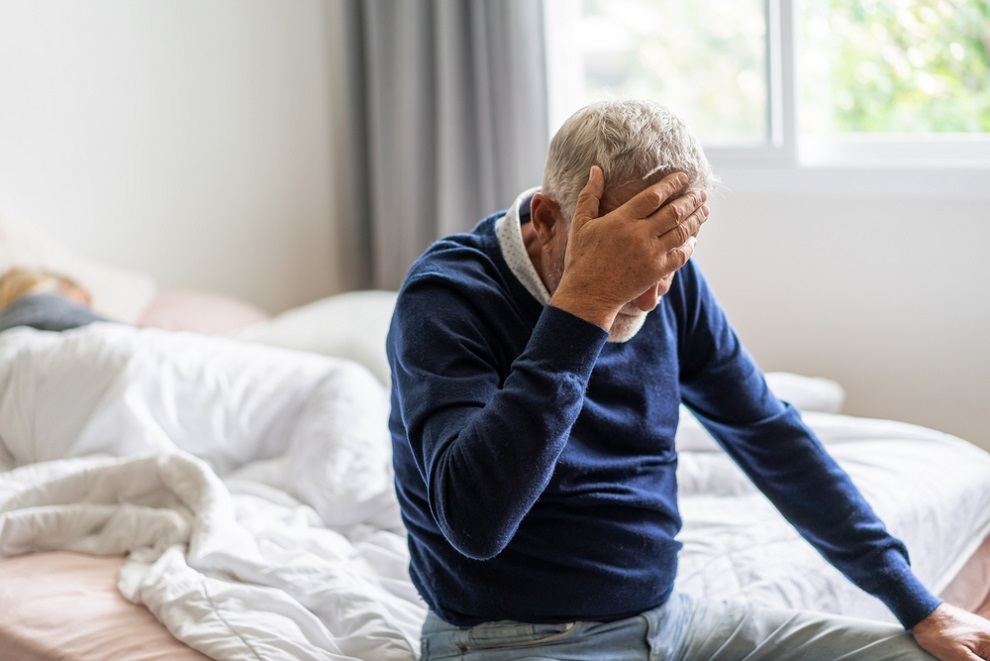Do you feel great in the morning but exhausted by the afternoon? This midday crash isn't just due to sleep or diet. Testosterone levels fluctuate throughout the day, and those shifts can affect energy, mood, and drive.
Testosterone is the primary male sex hormone responsible for muscle growth, bone strength, fat distribution, and libido. The pituitary gland controls testosterone production, responding to daily routines and overall health. It also affects mood, energy levels, and cognitive function. Although both men and women produce testosterone, adult men have significantly higher levels.
A study found that testosterone peaks in the morning and drops as the day progresses. For some, this shift is barely noticeable. However, certain factors can make the dip more extreme for others, causing low testosterone symptoms like brain fog, low energy, and irritability.
But why do testosterone levels fluctuate? This blog explains the reasons behind this fluctuation and how daily rhythms impact energy, mood, and health.

What Are Normal Testosterone Levels?
Testosterone levels aren't the same for everyone. They shift with different life stages, lifestyles, and overall health. This hormone affects energy, strength, and mood, but what's “normal†depends on the person.
Over time, levels naturally decline. Aging males may notice slower recovery after workouts, male pattern baldness, changes in weight, or shifts in sex drive. However, aging affects everyone differently, with some men maintaining steady levels for decades.
A normal range for adult men is 300 to 1,000 ng/dL. But numbers alone don't tell the whole story. Some men feel great at the lower end, while others experience symptoms of low testosterone even when their levels seem fine. These levels also fluctuate throughout the day. Stress, diet, and sleep can cause temporary dips. Some men have testosterone deficiency due to genetics or medical conditions.
How Testosterone Works And Why It Fluctuates
Testosterone follows a daily rhythm controlled by the pituitary gland and adrenal glands. The pituitary gland signals the testes to make testosterone, while the adrenal glands contribute smaller amounts.
This hormone affects muscle mass, energy levels, and metabolism. Testosterone levels are high in the morning and gradually decline as the day progresses. Serum testosterone reaches its highest point after waking up and drops by late afternoon. This natural fluctuation is part of the body's internal clock, which regulates performance and recovery.
Other hormones also play a part in making testosterone fluctuate. Cortisol, the body's stress hormone, can suppress testosterone when it stays high for long periods. Sex hormone-binding globulin (SHBG) affects how much testosterone is available, with higher SHBG levels reducing free testosterone in the body.
Fluctuations also vary by age. Adult men experience sharper peaks and declines, while older men have a more gradual drop in testosterone over time. This shift can affect energy, recovery, and overall health. Daily fluctuations are normal, but lifestyle choices can make the dips more noticeable. Poor sleep, high stress, and inactivity can lead to lower testosterone levels throughout the day.
Daily Testosterone Fluctuations: What's Considered Normal?
Testosterone levels do not remain constant throughout the day. Instead, they follow a diurnal pattern, rising and falling in response to the body's internal clock.
This rhythm is controlled by the hypothalamic-pituitary-gonadal (HPG) axis, which regulates hormone production based on time of day. Testosterone is highest in the morning. While you sleep, your body increases testosterone production. The pituitary gland releases luteinizing hormone (LH), which signals the testes to produce more testosterone.
By the time you wake up, levels are at their peak. As the day progresses, testosterone production slows down, leading to lower levels by the late afternoon and evening. Other hormones also influence this cycle. Cortisol, the hormone that helps with alertness and stress management, follows the same pattern as testosterone. It peaks in the morning and drops later in the day, which suggests that testosterone and cortisol serve complementary rather than antagonistic functions.
Another factor is sex hormone-binding globulin (SHBG), a protein affecting how much testosterone is available. SHBG levels change throughout the day, impacting testosterone activity. Age is another factor that affects how testosterone fluctuates. In younger men, morning levels are noticeably higher than evening levels. In older men, the difference between morning and evening testosterone is smaller because overall production slows with age.
However, the daily rise-and-fall pattern remains. Keep in mind that the body's natural cycle maintains balance. This fluctuation allows testosterone to support different physiological functions at optimal times, such as promoting muscle repair at night and boosting energy levels in the morning.
Factors That Lower Testosterone
Testosterone levels don't stay the same all day, and external factors can cause noticeable dips. While natural rhythms are important, lifestyle choices and environmental influences can also affect how much testosterone the body produces at different times. Let's look at some of the external factors that cause low T levels.
Poor Sleep
Testosterone production increases during deep sleep, especially in the REM stage.
Poor sleep reduces the time the body has to produce hormones, leading to lower levels in the morning. Men who sleep less than five hours a night can experience a 10-15% drop in testosterone. Irregular sleep patterns, sleep apnea, and frequent nighttime disturbances also contribute to this decline.
Get better sleep to keep serum testosterone levels steady. Stick to a consistent bedtime, avoid caffeine late in the day, and reduce screen time before bed to notice a difference. If needed, create a dark, quiet sleeping environment and address sleep apnea issues to support hormone production.
Stress and High Cortisol
Stress triggers the release of cortisol, which is a hormone that directly competes with testosterone. When cortisol remains high for long periods, testosterone production slows down.
Men with demanding jobs, high anxiety, or ongoing emotional stress often experience testosterone decline, especially in the late afternoon and evening. Handling stress is essential for preserving healthy testosterone levels. Practice relaxation techniques like yoga, deep breathing, meditation, or a short daily walk, which can help lower cortisol.
Nutrient Deficiencies
Testosterone production relies on key nutrients like zinc, magnesium, and vitamin D.
Diets lacking in these nutrients can interfere with hormone balance. Excessive sugar and processed foods also spike insulin levels, which can cause testosterone deficiency over time. Men who don't eat enough healthy fats may also see lower testosterone levels during the day. A nutrient-rich diet supports stable testosterone and overall well-being.
Foods high in zinc, like beef, oysters, and pumpkin seeds, regulate hormone levels. Consume magnesium-rich sources like spinach, almonds, and dark chocolate to boost testosterone production. Vitamin D from sunlight, fatty fish, and fortified foods support healthy hormone function. Replace processed foods with whole, nutrient-dense options to stabilize insulin and prevent hormonal imbalances.
Sedentary Lifestyle and Overtraining
A lack of physical activity causes testosterone to decline, but too much exercise can have the same effect.
Strength training supports hormone production, but excessive cardio or intense workouts without enough recovery time can increase cortisol and lower testosterone. Men who overtrain may experience dips in testosterone in the evening and feel more fatigued than usual.
Moderation is essential when it comes to exercise. Pair strength training and high-intensity workouts to allow hormone levels to recover. Schedule 3-4 strength training sessions per week with adequate sleep and nutrition to maintain total testosterone levels. Engage in light activities like walking, stretching, or yoga on rest days to support well-being without causing additional stress on the body.
Environmental Toxins
Everyday chemicals can interfere with hormone balance.
Plastics, pesticides, and certain grooming products contain endocrine disruptors like BPA and phthalates, which have been linked to lower testosterone. Regular exposure to these chemicals, especially over time, contributes to declining testosterone levels throughout the day.
Switch to stainless steel or glass jars instead of plastic to reduce BPA intake. Choose organic foods to minimize pesticide exposure. Additionally, check ingredient labels on personal care products and opt for natural, fragrance-free options to reduce exposure to endocrine disruptors.
Alcohol and Caffeine
Alcohol disrupts hormone production, especially when consumed in large amounts.
Excessive drinking reduces total testosterone levels by affecting the liver's ability to metabolize hormones. Moderate caffeine consumption can help maintain testosterone levels, but consuming too much, particularly in the evening, may disrupt sleep and indirectly lead to reduced testosterone levels.
What Happens When There's Too Much Testosterone?
Testosterone supports physical appearance, muscle growth, bone strength, and overall vitality. While higher levels bring certain benefits, too much can throw off the body's natural balance.
Natural testosterone increases from genetics or lifestyle adjustments are different from artificially raised testosterone, which can cause unwanted effects. Men with high testosterone levels tend to build muscle mass more easily and recover faster after workouts. They also have stronger bones and a lower the risk of fracture, along with an increased red blood cell count to help with endurance.
Many also notice heightened libido and a boost in confidence since testosterone also improves mood and sexual health. However, too much testosterone isn't always a good thing. It can cause unpredictable mood swings, irritability, and even aggressive behavior. Some men experience acne flare-ups due to increased oil production. Higher levels also speed up facial and body hair growth but may contribute to hair loss on the scalp.
Long-term hormonal imbalances can also affect fertility. Higher testosterone often results from genetics, weight training, and a well-rounded diet. On the other hand, anabolic steroids and testosterone boosters flood the body with synthetic hormones, often at dangerous levels.
When testosterone is artificially raised, the body may slow down its production. Many who take steroids experience withdrawal symptoms and long-term health complications once they stop.

Maintain Healthy Testosterone Levels Through Supplements
Testosterone levels shift throughout the day, but there are ways to support balance. A combination of nutrition, lifestyle changes, and, in some cases, targeted therapy can help prevent excessive dips.
Nutrients That Support Testosterone
Certain vitamins and minerals influence testosterone production. Zinc contributes to hormone synthesis, while vitamin D supports hormonal function.
Magnesium supports muscle recovery and testosterone balance, and omega-3 fatty acids regulate inflammation, which can affect hormone levels. Maintaining a nutrient-rich diet can provide natural support.
Herbal Supplements and Natural Boosters
Some men turn to herbal remedies for additional support. Ashwagandha is linked to higher testosterone levels and lower cortisol, while fenugreek may help maintain hormonal balance.
Additionally, Tongkat Ali has been studied for its effectiveness in improving total testosterone in men, particularly those with low T. A 2015 double-blind, placebo-controlled study found that men consuming 300 mg of ashwagandha root extract twice a day experienced a significant increase in testosterone levels compared to the placebo group. While research on these supplements continues, some men find them beneficial to a healthy lifestyle.
Testosterone Therapy
Personalized treatment options make it easier to maintain stable levels. Injectable and transdermal therapies have become popular solutions, offering a controlled and consistent release.
Male Excel provides testosterone cypionate injections and lipoderm cream, which help men maintain hormonal stability without sudden fluctuations. These therapies allow for a more tailored approach, ensuring testosterone remains at an optimal level throughout the day.
Conclusion
Why do testosterone levels fluctuate is a question worth asking, especially when you notice symptoms like low energy, mood swings, or a reduced sex drive.
Adapt simple habits like better sleep, regular exercise, and stress control to maintain steady levels. However, if symptoms persist, a blood test can provide clarity on whether testosterone levels are outside the normal range. In such cases, it might be time to consider a more targeted approach.
Male Excel offers personalized solutions designed for steady, reliable hormone support. With testosterone therapy from Male Excel, you can balance hormone levels, improve energy levels and mood, and achieve overall well-being.

Get TRT Online
Optimize Your Hormones





